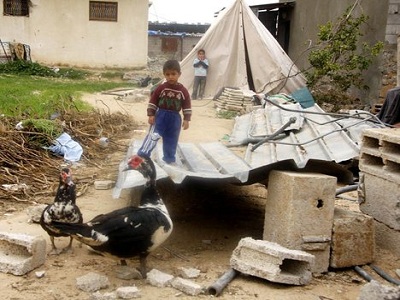
Fouad Abu Asser and his family have returned to their neighborhood amid the rubble of the Gaza Strip — but something resembling a shed is what they now call home.
“We hear talk and more talk, but we still haven’t seen anything,” the 54-year-old father said, referring to the slow pace of rebuilding in the Gaza Strip, devastated by last summer’s war with Israel.
Wednesday marks a year since the war’s start, and thousands of homes in Gaza still have not been rebuilt, forcing residents like Abu Asser to construct makeshift houses where they once lived out of prefabricated supplies or rubble.
The delay has been blamed on a variety of reasons, including Israel’s strict blockade preventing the shipment of construction material into the coastal enclave and the failure of promised money to arrive from international donors.
The result has been Gazans seeking to house their families in whatever way they can, with some 18,000 homes either destroyed or severely damaged during the 50-day war.
At the height of the conflict, the third in six years, the United Nations had transformed 91 of its schools in the Gaza Strip into shelters to house some 300,000 displaced. Short of money, the UN agency for Palestinian refugees recently closed the last shelter.
Some of the displaced have been able to return home, but more than 100,000 remain homeless — more than five percent of the Strip’s 1.8 million population.
It is a major part of the misery facing Gazans a year after the war, which killed 2,251 Palestinians, including 551 children, and 73 people on the Israeli side.
‘Our only Option’
Abu Asser put together three prefabricated cabins — forming two floors — amid the rubble of his former home. Provided by Jordan, the cabins resemble the type used at construction sites, with white and grey walls.
There is a room about nine square meters inside the first floor — not much bigger than a large closet — as well as a small kitchen and bathroom. The two others of the same size are perched on the gutted building’s concrete slabs above.
Fifteen family members live in the makeshift complex, including two of Abu Asser’s grandchildren who are disabled.
“I live with my wife and our children in a prefabricated cabin on the ground floor and my sons Bashir and Salah live with their families in two prefabricated cabins above,” said Abu Asser, who is among the 44 percent of Gazans who are unemployed — what the World Bank says is likely the highest rate anywhere.
He said he was aware of the risks of collapse, but went ahead with the Lego-like construction anyway “because it was our only option after having suffered so much”, with the family having constantly relied on others for shelter.
Many other Gazans have used similar types of construction or even more basic materials to provide shelter for themselves.
‘No Future’
There has not been a total lack of progress in rebuilding, but the work done so far has been nowhere near what is necessary.
A spokesman for UN relief agency UNRWA, Adnan Abu Hasna, said 61,000 homes have been renovated. However, such work has often involved relatively minor repairs apart from the 18,000 destroyed or severely damaged homes.
Millions of dollars were pledged to Gaza by international donors at a conference in Cairo in October, but much of it has not been delivered.
Robert Turner, UNRWA operations director for Gaza, said the agency has only received financing for 200 homes — despite having to rebuild 7,000 under his program.
Essam Jouda has been trying to maintain hope, if only for the benefit of his 10-year-old son, Thaer, who lost his leg in the war and spent months recovering in a German hospital.
Jouda had not informed his son that his mother and four of his brothers and sisters had been killed in the war until he returned.
“When I would call my father, he would tell me that my mother and my brothers and sisters were sleeping,” Thaer said with tears in his eyes. “I was angry with mum because she never spoke to me. Actually mum is in paradise.”
They are now living in a prefabricated cabin at a refugee camp in the north of the Gaza Strip.
“We want to live, but without reconstruction of our homes, we will have no life and our children will have no future,” said the 54-year-old Jouda.
(Ma’an – www.maannews.net)





